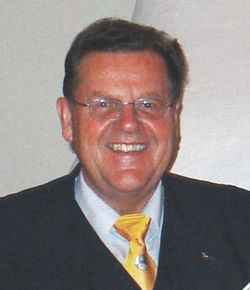Whistler (pps) “A worthy season’s final” – this is how Josef Fendt of Berchtesgaden (Germany), President of the International Luge Federation, FIL, described the ninth and last stop of the Viessmann Luge World Cup series on the future Olympic track for the 2010 Olympic Winter Games in Whistler, Canada. In view of top speeds of up to 154 km/h in the men’s singles, the former World champion and 1976 Olympic silver medallist warned about “premature cheers”. “Facing such high top speeds we, as the international federation, need to keep in mind the safety of our athletes”, explained Fendt. This is why FIL and the Organising Committee VANOC have already discussed special training options for the “weaker” luge nations and decided upon two modifications of the track. Fendt: “Apart from that, the Olympic Games could well start tomorrow.”
In the pre-Olympic season, the FIL registered a surprisingly vast number of top performances. A total of six nations (Germany, Italy, USA, Austria, Ukraine and Latvia) have earned at least one medal at the 41st FIL Luge World Championships in Lake Placid in the US state of New York. The hosts made optimum use of their home advantage with Erin Hamlin capturing gold
and a bronze medal for the doubles’ team with Mark Grimmette-Brian Martin. And again six nations – Germany, Italy, Austria, Ukraine, Russia and Latvia - took podium finishes in the Viessmann Luge World Cup series.
Even though the US lugers failed to make the podium in the Viessmann Luge World Cup,Russia took a third place in the statistics thanks to a victory and another third place of Albert Demchenko. Thus, altogether seven nations have earned medals at the World Championships or stood atop the podium in the Viessmann Luge World Cup.
Once again, two-time Olympic and five-time World champion Armin Zoeggeler of Italy proved to be the top athlete per-se. He achieved five victories, two second and one third place, followed by Germany’s David Moeller (1-3-3). Though Germany’s two-time World Champion Felix Loch is still waiting for his first World Cup success after his injury at the start of the season, he made the podium at his six World Cup competitions (0-4-2). A total of eight lugers took medals at the nine events of the Viessmann Luge World Cup series and Germany’s World bronze medallist Andi Langenhan achieved his first ever World Cup victory.
This season, however, only six women earned a medal. Overall World Cup champion Tatjana Huefner achieved six victories and three second places at nine competitions. Her compatriot Natalie Geisenberger celebrated three wins and five second places; she only failed to make the podium at the event in Sigulda. And Anke Wischnewski seemed to have subscribed to bronze medals – she earned seven third places. Apart from these three German women who achieved a winning series of 90 consecutive victories in the Viessmann Luge World Cup, Ukraine’s Natalya Yakushenko celebrated a second place in Sigulda and Austria’s Nina Reithmayer (third in Cesana) and Veronika Halder (third in Calgary) made the podium at least once.
In contrast, the doubles’ events were rather more exciting. No less than nine doubles’ teams from four nations – Italy, Germany, Austria and Latvia – made the podium at least once. Italy’s overall World Cup champions Christian Oberstolz-Patrick Gruber are heading this list, having earned five victories, followed by Germany’s Patric Leitner-Alexander Resch (1-3-1) and Italy’s World champions Gerhard Plankensteiner-Oswald Haselrieder (1-1-1). Additionally, the two German doubles’ teams with Tobias Wendl-Tobias Arlt (Oberhof) and André Florschuetz-Torsten Wustlich (Whistler) achieved victories, too.
Furthermore, the three Austrian doubles’ teams with 2006 Olympic champions Andreas Linger-Wolfgang Linger (0-2-3), two-time World champions Tobias Schiegl-Markus Schiegl (0-1-1) and the “young guns” Peter Penz-Georg Fischler (0-1-1) took medals. The Sics brothers Andris and Juris of Latvia earned a third place in Cesana.









